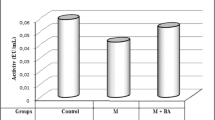Abstract
Erythrocyte cytoplasm of rats, mice and humans was incubated in head space vials with methyl chloride and the decline in concentration of the substance monitored as a parameter of metabolism. The production of S-methylglutathione was controlled by tlc. Rats, mice, bovines, pigs, sheep and rhesus monkeys showed no conversion of methyl chloride in erythrocyte cytoplasm. About 60% of the human blood samples showed a significant metabolic elimination of the substance (conjugators), whereas about 40% did not (non-conjugators). The production of S-methylglutathione indicated enzymatic metabolism of the substance by glutathione S-transferases. In literature, a “major” and “minor” form of human erythrocyte glutathione S-transferase has been described. The results indicate that the “minor” form is probably responsible for the unique metabolism of methyl chloride in human erythrocytes.
Similar content being viewed by others
References
Andersen ME, Gargas ML, Jones RA, Jenkins LJ (1980) Determination of the kinetic constants for metabolism of inhaled toxicants in vivo using gas uptake measurements. Toxicol Appl Pharmacol 54: 110–116
Awasthi YC, Singh SV (1984) Purification and characterization of a new form of glutathione S-transferase from human erythrocytes. Biochem Biophys Res Commun 125: 1053–1060
Boyum A (1964) Separation of white blood cells. Nature 204: 793–794
Deutschmann S, Reichel C, Kettschau F (1989) Metabolism of methyl bromide and methyl iodide in erythrocytes compared with methyl chloride. Naunyn-Schmiedeberg's Arch Pharmacol Suppl 339: R 12
Dirr HW, Schabort JC (1987) Glutathione S-transferase composition of rat erythrocytes. Biochem Int 15: 381–384
Dirr HW, Schabort JC (1988) Purification and partial characterization of the glutathione S-transferase of rat erythrocytes. Biochim Biophys Acta 957: 173–177
Doorr R van, Borm PJA, Leijdekkers Ch-M, Henderson PTh, Reuvers J, Bergen TJ van (1980) Detection and identification of S-methylcysteine in urine of workers exposed to methyl chloride. Int Arch Occup Environ Health 46: 99–109
Guthenberg C, Mannervik B (1981) Glutathione S-transferase (transferase π) from human placenta is identical or closely related to glutathione S-transferase (transferase ϱ) from erythrocytes. Biochim Biophys Acta 661: 255–260
Habig WH, Pabst MJ, Jakoby WB (1974) Glutathione S-transferases. The first enzymatic step in mercapturic acid formation. J Biol Chem 249: 7130–7139
Hayes JD, Mantle TJ (1986) Anomalous electrophoretic behaviour of the glutathione S-transferase Ya and Yk subunits isolated from man and rodents. Biochem J 237: 731–740
Jäger R, Peter H, Sterzel W, Bolt HM (1988) Biochemical effects of methyl chloride in relation to its tumorigenicity. J Cancer Res Clin Oncol 114: 64–70
Johnson MK (1966) Studies on glutathione S-alkyltransferase of the rat. Biochem J 98: 44–55
Kornbrust DJ, Bus JS (1983) The role of glutathione and cytochrome P-450 in the metabolism of methyl chloride. Toxicol Appl Pharmacol 67: 246–256
Marcus CJ, Habig WH, Jakoby WB (1978) Glutathione transferase from human erythrocytes. Arch Biochem Biophys 188: 287–293
Nolan RJ, Rick DL, Landry TD, McCarty LP, Agin GL, Saunders JH (1985) Pharmacokinetics of inhaled methyl chloride (CH3Cl) in male volunteers. Fund Appl Toxicol 5: 361–369
Redford-Ellis M, Gowenlock AH (1971) Studies on the reaction of chloromethane with human blood. Acta pharmacol toxicol 30: 36–48
Seidegard J, Vorachek WR, Pero RW, Pearson WR (1988) Hereditary differences in the expression of the human glutathione transferase active on trans-stilbene oxide are due to a gene deletion. Proc Natl Acad Sci USA 85: 7293–7297
Stewart RD, Hoke CL, Wu A, Graff SA, Forster HV, Keeler WH, Lebrun AJ, Newton PE, Soto RJ (1977) Methyl chloride: development of a biological standard for the industrial worker by breath analysis. Natl. Inst. Occup. Safety Health Rep. No. NIOSH-MCOW-ENVM-MCM-77-1
Strange RC, Johnson PH, Lawton A, Moult JA, Tector MJ, Tyminski RJ, Cotton W (1982) Studies on the variability of glutathione S-transferase from human erythrocytes. Clin Chim Acta 120: 251–260
Suzuki T, Coggan M, Shaw DC, Board PG (1987) Electrophoretic and immunological analysis of human glutathione S-transferase isozymes. Ann Hum Genet 51: 95–106
Warholm M, Guthenberg C, Mannervik B (1983) Molecular and catalytic properties of glutathione transferase μ from human liver: an enzyme efficiently conjugating epoxides. Biochemistry 22: 3610–3627
Author information
Authors and Affiliations
Rights and permissions
About this article
Cite this article
Peter, H., Deutschmann, S., Reichel, C. et al. Metabolism of methyl chloride by human erythrocytes. Arch Toxicol 63, 351–355 (1989). https://doi.org/10.1007/BF00303122
Received:
Revised:
Accepted:
Issue Date:
DOI: https://doi.org/10.1007/BF00303122




